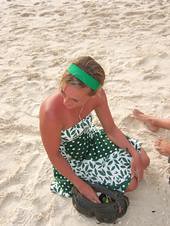Phi Phi Clean-up Days...

On the occassion of H.M. King Bhumibol, who truly inspires and works with and for his people's, 80th birthday Ko Phi Phi hosted a 3 day clean-up operation. (A small trivia aside: King Bhumibol, the 9th King of Thailand, is the longest reigning monarch in world history).
On day 1 (3rd December) Ya, Linda (a customer who had been diving with us for a number of weeks) and I joined the Coral Transplantation Group. Approx. 10 months ago Andrew Hewitt (of the Adventure Club and Phi Phi Dive Camp) in partnership with the Phuket Marine Biological Center, the National Institute of Oceanography in Israel, and supported by the European Commission created a coral nursery near Phi Phi Ley. The nursery consists of racks and mesh trays suspended above the substrate, allowing juvenile coral fragments removed from donor colonies to grow with a reduced threat from sedimentation and corallivoes.
Rehabilitation sites (between the depths of 6 and 13 metres on the site of Table Coral City)had been marked out for us with small buoys and string and photographed. The transplantation involves locating natural burrows in the hard substrate (or large dead corals) and then using a nail and hammer, or handscrew, to enlarge the burrow to the size of the coral fragment's lower tip (which is enclosed in a plastic tube). Approx. 1 inch of this lower tip is inserted into the hole with the living part of the coral fragment then touching the substrate. A bamboo stick may also be inserted as a wedge to ensure that the fragment stays tightly in place against water motion and fish attempting to feed. If properly installed the fragments start to build a calcium carbonate base and attach themselves to the substrate within one month. These juvenile fragments will grow and in time fuse together.


On the more experiential aspect of this we had a great time although this was HARD work!!! A 103 minute dive and 87 minute dive later I was pretty achey. The increased resistance of water as opposed to air means that hammering into hard substrate takes some doing!!!And on land I guess I must use my weight or body as resistance when I'm using a screw, so it was trial and error working out how to do so underwater where in effect I was weightless!! Once I had the technique though I was pretty satisfied with my efforts, and Linda's assistance in passing me all the tools I needed whilst maintaining neutral buoyancy. We also had to ensure that the fragments are inserted not too near living or different types of coral as these may actually attack each other...
Day 2 involved Lisa, Tee and Bell joining the Long Beach dive site clean-up, bringing up marine debris.
Day 3: Keira, Bell and Tee were involved in cleaning up the underwater tsunami memorial and then in the release of clownfish (nemo's) into vacant anemones. Around 1000 clownfish were shipped over from a Krabi fish farm and divers took them down in jamjars, located anemones with no clownfish living in them and introduced them hoping for appropriate habitat and the ensuing symbiotic relationship. Bell in particular loved this day, and I quite wish I could have gone along too!!!






0 Comments:
Post a Comment
Subscribe to Post Comments [Atom]
<< Home